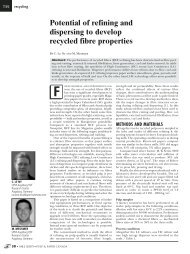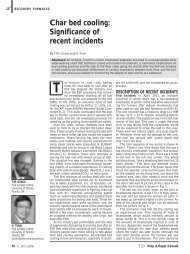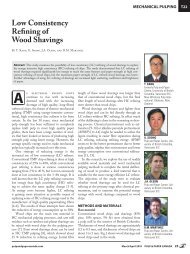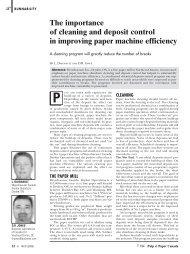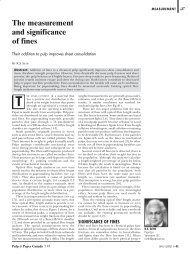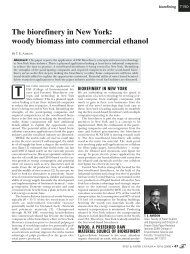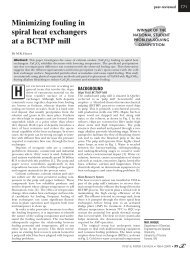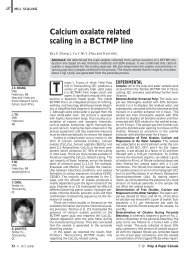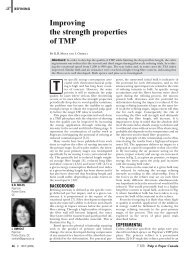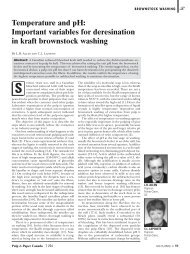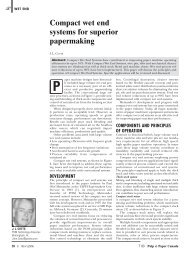Fines from deinked pulp: Effect of contaminants on their ...
Fines from deinked pulp: Effect of contaminants on their ...
Fines from deinked pulp: Effect of contaminants on their ...
You also want an ePaper? Increase the reach of your titles
YUMPU automatically turns print PDFs into web optimized ePapers that Google loves.
BRIGHTNESSperfectly complement each other [6].— <str<strong>on</strong>g>Fines</str<strong>on</strong>g> <str<strong>on</strong>g>from</str<strong>on</strong>g> UNP:UMG: The fines <str<strong>on</strong>g>from</str<strong>on</strong>g> UNP:UMG (Table III)had the highest brightness due to <strong>their</strong> origin (30% bleachedmagazine at an ISO brightness <str<strong>on</strong>g>of</str<strong>on</strong>g> 68%, and 70% <str<strong>on</strong>g>of</str<strong>on</strong>g> newsprint atan ISO brightness <str<strong>on</strong>g>of</str<strong>on</strong>g> 60.4%). The ERIC value <str<strong>on</strong>g>of</str<strong>on</strong>g> the UNP:UMGfines was 125 ppm, higher than the 75 ppm for the TMP fines,but lower than the 450-ppm <str<strong>on</strong>g>of</str<strong>on</strong>g> the DIP fines. The 30% DIP c<strong>on</strong>tentin the UNP could explain this intermediate ERIC value.Due to <strong>their</strong> prior bleaching history, high Fe c<strong>on</strong>centrati<strong>on</strong> andink carried over <str<strong>on</strong>g>from</str<strong>on</strong>g> recycling, the UNP:UMG fines bleachabilitywas intermediate to those <str<strong>on</strong>g>of</str<strong>on</strong>g> the DIP and TMP; however,<strong>their</strong> final brightness was <strong>on</strong>ly slightly lower than that <str<strong>on</strong>g>of</str<strong>on</strong>g> theTMP fines.The peroxide bleaching resp<strong>on</strong>se was poor when it was notpreceded by a metal-management stage (<strong>on</strong>ly 0.6 <str<strong>on</strong>g>of</str<strong>on</strong>g> a brightnesspoint); however, it was still better than the DIP fines resp<strong>on</strong>se(–2.3 brightness points), but less than the TMP fines resp<strong>on</strong>se(10.0 brightness points). A metal-management stage improvedthe ISO brightness gain following peroxide bleaching by nearly10 points, to 67.2%. The ISO brightness increase was betweenthat <str<strong>on</strong>g>of</str<strong>on</strong>g> DIP (2.3 brightness points) and TMP (13.9 brightnesspoints), but the final brightness was similar to that <str<strong>on</strong>g>of</str<strong>on</strong>g> the TMP.The maximum ISO brightness gain was 11.9 points following aQPY-stage, less than the 17.8 brightness points gain for TMP butgreater than the 8.0 brightness points for DIP. The maximumISO brightness attained for the UNP:UMG fines was 68.8%,close to the 70.4% value for the TMP fines, and definitely higherthan that <str<strong>on</strong>g>of</str<strong>on</strong>g> the DIP fines (55.7%).We can c<strong>on</strong>clude that fines that have never been throughprinting resp<strong>on</strong>d well to bleaching reagents, provided they aretreated with a metal-management stage. For each furnish, theratio <str<strong>on</strong>g>of</str<strong>on</strong>g> the maximum ISO brightness gains <str<strong>on</strong>g>of</str<strong>on</strong>g> the fines (TableIII) over that <str<strong>on</strong>g>of</str<strong>on</strong>g> the original <str<strong>on</strong>g>pulp</str<strong>on</strong>g>s (Table II) were 0.68 for DIP(8.0/11.8), 1.01 for TMP (17.8/17.6) and 1.05 for UNP:UMG(11.9/11.3), which illustrates again how the high ERIC <str<strong>on</strong>g>of</str<strong>on</strong>g>the DIP fines limited the final brightness gain <str<strong>on</strong>g>of</str<strong>on</strong>g> the unfracti<strong>on</strong>ated<str<strong>on</strong>g>pulp</str<strong>on</strong>g>s.It is interesting to note that the l<strong>on</strong>g fracti<strong>on</strong>s <str<strong>on</strong>g>of</str<strong>on</strong>g> the DIP andUNP:UMG had similar brightness gains and final brightnesses(Table II), while <strong>their</strong> fines bleachability differed significantly.Therefore, the processing <str<strong>on</strong>g>of</str<strong>on</strong>g> the <str<strong>on</strong>g>pulp</str<strong>on</strong>g> into paper did not significantlyaffect its bleachability, as noted previously by Galland etal. [7]. However, the printing process did affect the bleachabilitydue to the poor deinking <str<strong>on</strong>g>of</str<strong>on</strong>g> the fines.CONCLUSIONInk was extremely difficult to detach and seemed to be permanentlybound to the DIP fines; it was the major factor limiting<strong>their</strong> brightness gain.Ir<strong>on</strong> had a str<strong>on</strong>g affinity for fines. Without a proper metalmanagementstage, <strong>their</strong> high level <str<strong>on</strong>g>of</str<strong>on</strong>g> ir<strong>on</strong> decreased the performance<str<strong>on</strong>g>of</str<strong>on</strong>g> hydrosulphite bleaching. The peroxide bleachingefficiency <strong>on</strong> fines <str<strong>on</strong>g>from</str<strong>on</strong>g> UNP:UMG or DIP was practically nilwithout an acid wash or a chelati<strong>on</strong> stage.Therefore, even if fines have a higher percentage <str<strong>on</strong>g>of</str<strong>on</strong>g> ligninthan the l<strong>on</strong>g fracti<strong>on</strong>, they can nevertheless be bleached tohigh brightness if they are not c<strong>on</strong>taminated by ink. To bleachDIP to high brightness, either fines have to be removed or a processto detach and remove ink <str<strong>on</strong>g>from</str<strong>on</strong>g> fines is necessary.The fines that had been processed, for example, througha paper machine, had a brightness ceiling similar to the finesthat had not been processed, as l<strong>on</strong>g as ink was absent <str<strong>on</strong>g>from</str<strong>on</strong>g>that process.LITERATURE1. SCOTT, G.M., ABUBAKR, S. Fracti<strong>on</strong>ati<strong>on</strong> <str<strong>on</strong>g>of</str<strong>on</strong>g> sec<strong>on</strong>dary fiber — A review. Prog.Pap. Recycling 3: 50-59 (1994).2. LAPIERRE, L., PITRE, D., BOUCHARD, J. Bleaching <str<strong>on</strong>g>of</str<strong>on</strong>g> <str<strong>on</strong>g>deinked</str<strong>on</strong>g> recycled <str<strong>on</strong>g>pulp</str<strong>on</strong>g>:benefits <str<strong>on</strong>g>of</str<strong>on</strong>g> fibre fracti<strong>on</strong>ati<strong>on</strong>. Pulp Paper Can. 102(2): 35-38 (2001).3. EUL, W., SÜSS, H.U., HELMLING, O. Fibre fracti<strong>on</strong>ati<strong>on</strong> and post-treatment <str<strong>on</strong>g>of</str<strong>on</strong>g>de-inked <str<strong>on</strong>g>pulp</str<strong>on</strong>g>. Pulp Paper Can. 90(10): T391-397 (1989).4. KARNIS, A. Pulp fracti<strong>on</strong>ati<strong>on</strong> by fibre characteristics. Pap. Puu 79(7): 480-488(1997).5. JORDAN, B., O’NEIL, M. The Kubelka-Munk absorpti<strong>on</strong> coefficient <str<strong>on</strong>g>of</str<strong>on</strong>g> severalcarb<strong>on</strong> blacks and water based printing inks. JPPS 20(12): J371-375 (1994).6. AUHORN, W., MELZER, J. Ec<strong>on</strong>omical integrati<strong>on</strong> <str<strong>on</strong>g>of</str<strong>on</strong>g> mechanical <str<strong>on</strong>g>pulp</str<strong>on</strong>g> bleachinginto modern paper technology. Wochenbl. Papierfabr. 110(8): 255-262 (1982).7. GALLAND, G., BERNARD, G., SAURET, G. Désencrage: Intérêt des traitements«haute c<strong>on</strong>centrati<strong>on</strong>», Rev. ATIP 37(9): 559-566 (1983).Résumé: Nous av<strong>on</strong>s récemment présenté un rapport indiquantque la blancheur et l’aptitude au blanchiment des fines de pâte désencrée(PDE) étaient en général substantiellement inférieures à celles dela fracti<strong>on</strong> de fibres l<strong>on</strong>gues. Nous ne savi<strong>on</strong>s pas à ce moment ce quiavait entraîné la pauvre rép<strong>on</strong>se des fines de PDE aux agents deblanchiment. Nous av<strong>on</strong>s c<strong>on</strong>clu que deux facteurs liés à la c<strong>on</strong>taminati<strong>on</strong>externe étaient la cause principale de la pauvre rép<strong>on</strong>se aublanchiment et au faible degré de blancheur maximale des fines dePDE : un taux effectif élevé d’encre résiduelle et une forte quantité demétaux de transiti<strong>on</strong>, principalement le fer.Reference: LAPIERRE, L., PITRE, D., BOUCHARD, J. <str<strong>on</strong>g>Fines</str<strong>on</strong>g> <str<strong>on</strong>g>from</str<strong>on</strong>g><str<strong>on</strong>g>deinked</str<strong>on</strong>g> <str<strong>on</strong>g>pulp</str<strong>on</strong>g>: <str<strong>on</strong>g>Effect</str<strong>on</strong>g> <str<strong>on</strong>g>of</str<strong>on</strong>g> <str<strong>on</strong>g>c<strong>on</strong>taminants</str<strong>on</strong>g> <strong>on</strong> <strong>their</strong> bleachability and <strong>on</strong> the<str<strong>on</strong>g>pulp</str<strong>on</strong>g> final brightness. Pulp & Paper Canada 104(8): T208-211 (August2003). Paper presented at the 6th Research Forum <strong>on</strong> Recycling inMagog, QC, <strong>on</strong> October 1 to 4, 2001. Not to be reproduced without permissi<strong>on</strong><str<strong>on</strong>g>of</str<strong>on</strong>g> PAPTAC. Manuscript received <strong>on</strong> August 10, 2001. Revisedmanuscript approved for publicati<strong>on</strong> by the Review Panel <strong>on</strong> December5, 2002.Keywords: FINES, DEINKED STOCK, BRIGHTNESS, BLEACH-ABILITY, CONTRARIES, TRANSITION METALS.Pulp & Paper Canada T 211 104:8 (2003) ❘❘❘ 39



